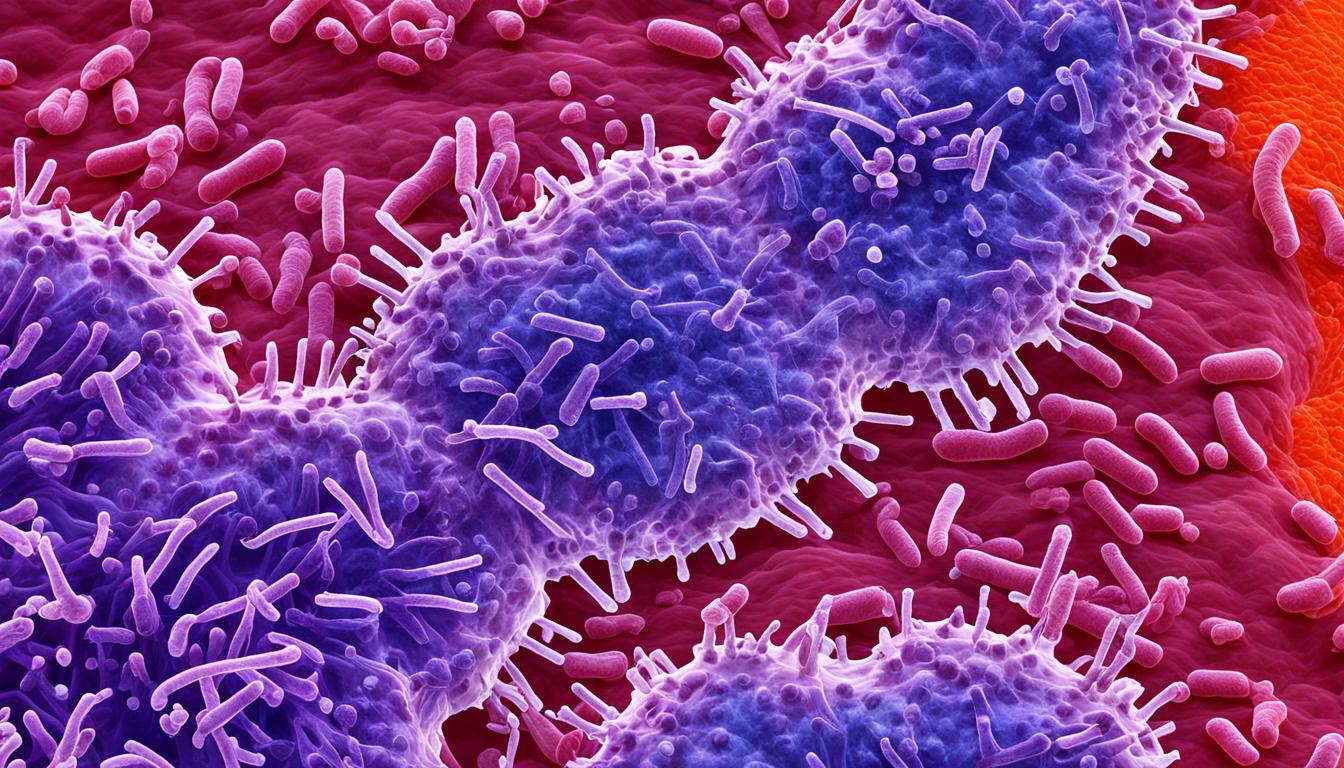Strep throat, or streptococcal pharyngitis, is a well-known infectious illness. It can affect anyone and comes from a bacteria called group A Streptococcus. This bacteria easily moves from one person to another through coughing or sneezing.
Its symptoms are a sore throat with white spots, fever, neck nodes swelling, and trouble swallowing. These signs can really make you feel bad and stop you from doing regular things.
To find out if someone has strep throat, a strep test is done. They take a sample from your throat to check for the bacteria. If it’s found, they recommend fast treatment with antibiotics for strep throat.
Recent studies suggest that stem cell therapy might also help fight strep throat. Stem cells can repair damaged tissues and help the body’s immune system. So, they could be another way to treat the infection, especially if it’s severe.
Key Takeaways:
- Strep throat is a contagious bacterial infection caused by group A Streptococcus bacteria.
- Common symptoms of strep throat include sore throat with white patches, fever, and difficulty swallowing.
- Diagnosis of strep throat involves a strep test to detect the presence of streptococcal bacteria.
- Treatment for strep throat typically involves antibiotics.
- Advancements in stem cell therapy show potential for treating severe strep throat infections.
What is Strep Throat and How Contagious is it?
Strep throat is a bacterial infection that irritates the throat, causing pain. It’s triggered by Group A Streptococcus. When people with it sneeze or cough, they send out tiny water drops into the air. This is why strep throat spreads easily, especially in places like schools and daycare.
Touching things that a sick person has touched, using the same eating tools, and staying close to someone with strep throat can all spread the sickness.
Unlike common sore throats from viruses, strep throat is caused by a different bacteria. You can get it by touching a sick person or breathing in their droplets. This shows how easily the sickness can hop from one person to another.
Let’s dig into how Group A Streptococcus spreads the disease.
Key Facts about Group A Streptococcus:
- Group A Streptococcus lives in the nose and throat of healthy people.
- It triggers different infections, from a simple strep throat to more serious diseases.
- The bacteria can live a short while on objects, making it possible to get infected by touching them.
- What’s scary is that those with strep throat can spread it even before they feel sick themselves. This is why finding the sickness early and isolating the sick person is key to stop it from spreading.
In short, strep throat is very contagious. It spreads through tiny droplets in the air, by touching a sick person, or using their stuff. Knowing how it spreads helps us take steps to prevent it and get treatment early, reducing how many people get sick.
Symptoms, Causes, and Complications of Strep Throat
Strep throat is a common bacterial infection that mainly affects the throat and tonsils. The Streptococcus pyogenes bacteria cause it. It leads to various symptoms and complications if not treated. Recognizing its symptoms is vital to get medical help in time and avoid spreading it.
Strep Throat Symptoms
Strep throat symptoms differ from person to person. Some common indicators are:
- Sore throat: A major sign is a very painful throat making swallowing hard. The throat may feel scratchy or tender, causing discomfort.
- Fever: It often comes with a high fever, often over 101 degrees Fahrenheit. This fever can last for several days.
- White patches: The presence of white or yellowish patches on the throat or tonsils is a classic sign of strep throat. These may look like pus-filled spots or a thick coating.
- Enlarged lymph nodes: Strep throat swells the lymph nodes in the neck. They may be sore and feel like small, round bumps.
Causes of Strep Throat
The cause is the Streptococcus pyogenes bacteria, also known as group A Streptococcus. It spreads through air when an infected person coughs, sneezes, or talks. Touching infected saliva or nasal secretions can also pass the bacteria. Sharing contaminated items like utensils or glasses can spread the infection too.
Complications of Strep Throat
Without treatment, strep throat can lead to various complications. These include:
- Tonsillitis: It can develop into tonsillitis. This includes severe tonsil inflammation, strong sore throat, and swollen tonsils, making swallowing hard.
- Rheumatic fever: A serious condition that affects the heart, joints, skin, and nervous system. It is a rare but serious complication of untreated strep throat.
- Ear infection: It can cause ear infections, mostly in children. Bacteria can move from the throat to the middle ear through the Eustachian tube.
Timely treatment with antibiotics is key to prevent complications and control strep throat. It’s essential to see a doctor at the first signs of the illness for the right diagnosis and treatment.
Advances in Strep Throat Treatment – Stem Cell Therapy
Recently, the treatment for strep throat has seen big improvements. Now, stem cell therapy is making its way into the scene. It’s a type of regenerative medicine. This field is promising for strep throat care.
Antibiotics are still top for treating strep. Yet, studies show stem cell therapy might aid by boosting the immune system. This could help patients with severe cases heal faster. Stem cells can change into different cell types. They help with tissue regrowth. So, they might be a key tool against diseases like strep throat.
Still, stem cell therapy for strep throat is just starting. Many studies and trials are underway to check if it works and is safe. The future looks bright. More progress in regenerative medicine means treating strep throat could get even better. This could mean a better life for those battling strep throat.

